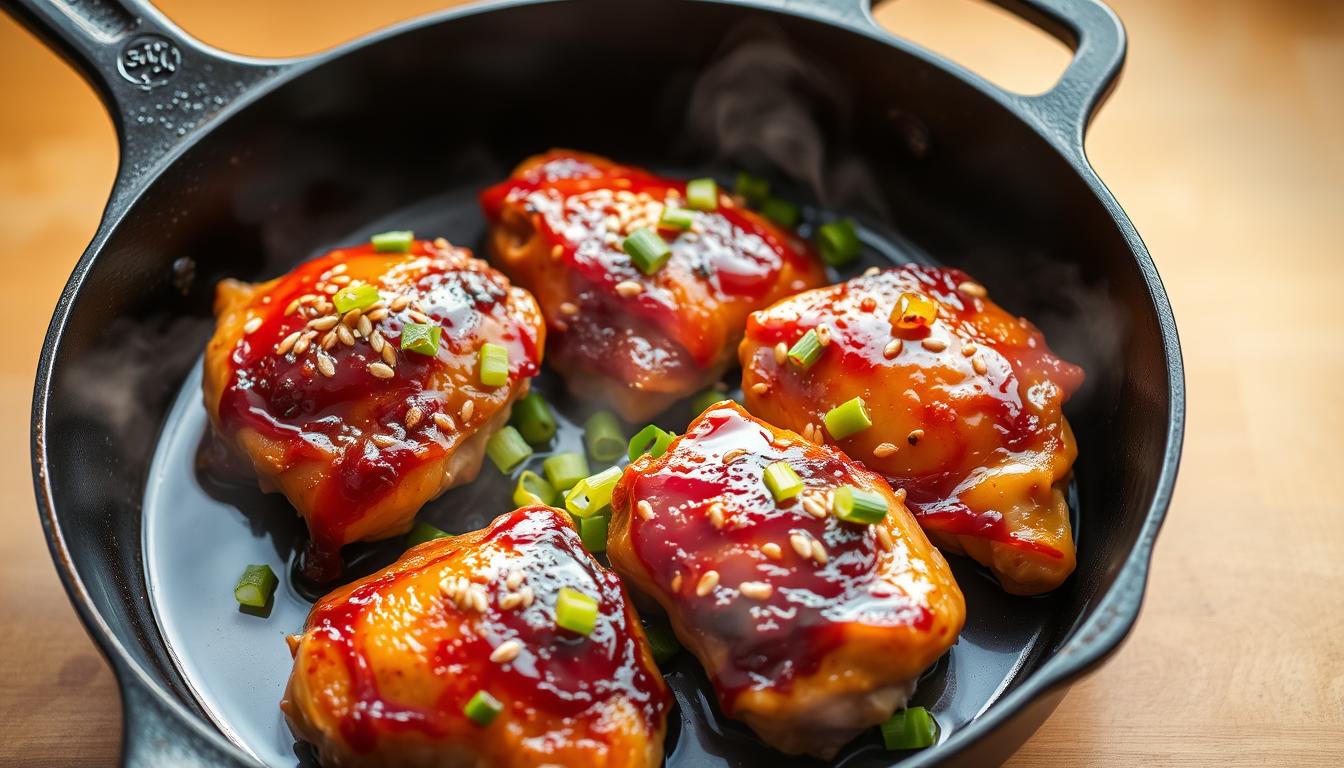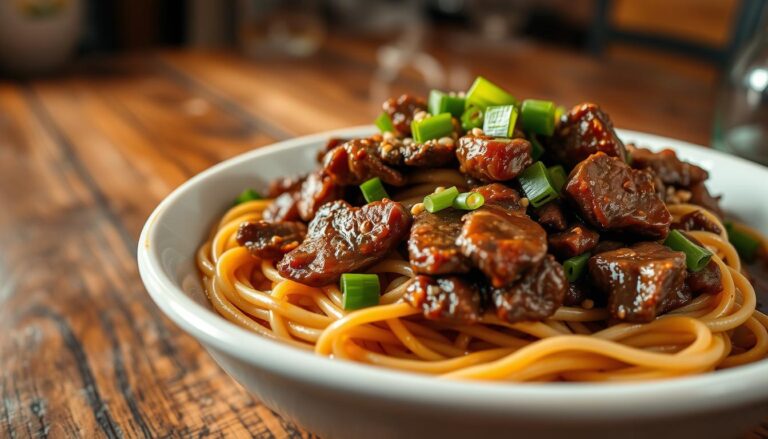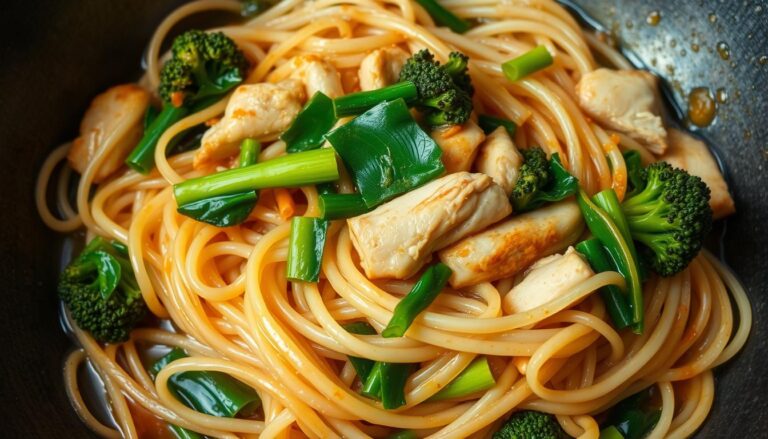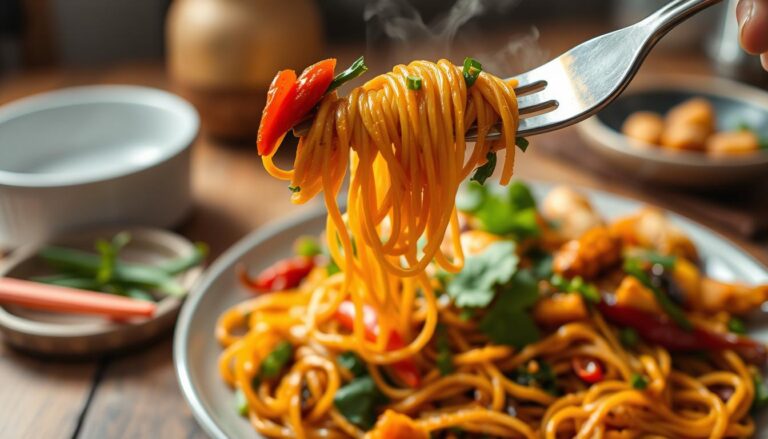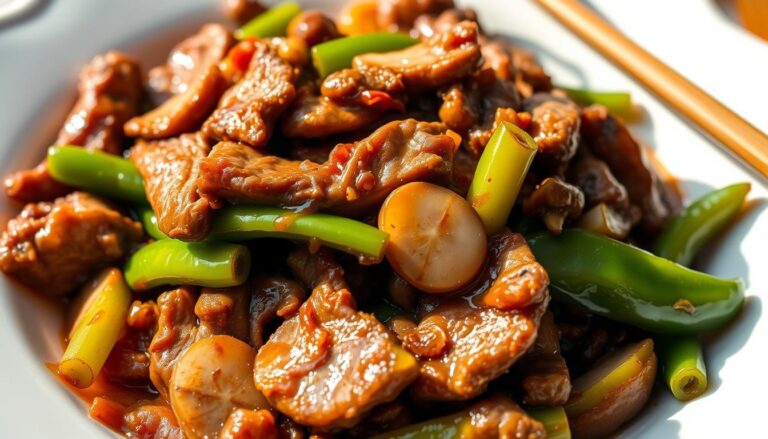Soy-Garlic Chicken Thighs: Your Delicious Meal Solution
Craving a flavor-packed dinner that’s easy to prepare? Look no further. This recipe transforms simple ingredients into a savory masterpiece. Imagine tender, juicy chicken with crispy skin glazed in a sticky-sweet sauce. It’s a crowd-pleaser that works for weeknights or casual gatherings.
What makes this dish stand out? The magic lies in balancing bold flavors. Garlic adds depth, while soy sauce brings umami richness. A touch of sweetness ties everything together. Best of all, you don’t need advanced cooking skills to nail it.
Using a cast iron skillet ensures even heat distribution. This helps achieve that golden-brown crust everyone loves. We’ll guide you through marinating tips to lock in moisture and maximize taste. You’ll also learn timing tricks to avoid overcooking.
Ready to upgrade your dinner rotation? Let’s dive into the ingredients and techniques that make this recipe unforgettable. From prep to plating, we’ve got you covered.
Key Takeaways
- Create restaurant-quality chicken with minimal effort using pantry staples
- Master the art of balancing sweet, salty, and garlicky flavors
- Discover why cast iron skillets deliver superior browning
- Learn marinating secrets for juicier results
- Follow foolproof steps for crispy skin and tender meat
Introduction to Soy-Garlic Chicken Thighs
This recipe redefines home cooking with bold flavors and foolproof techniques. At its core lies a dynamic duo: garlic’s aromatic punch and soy sauce’s savory depth. Together, they create a flavor symphony that clings to every bite.
What Makes This Recipe Unique
The magic happens when sweet honey dances with salty soy sauce. This balance elevates simple ingredients into something extraordinary. Bone-in, skin-on thighs stay juicy during cooking while developing a crispy exterior – a texture contrast you can’t get with boneless cuts.
Timing matters here. Letting the chicken marinate for exactly 30 minutes allows flavors to penetrate without breaking down the meat’s texture. You’ll use basic seasonings like salt and pepper to enhance – not overpower – the star ingredients.
Later sections will reveal precise measurements and cooking methods. You’ll learn how to achieve that perfect golden crust using everyday tools, plus creative ways to adapt the recipe to your taste. Get ready to transform your kitchen into a flavor lab.
Essential Ingredients and Tools
Great meals start with quality components. Your ingredient choices directly impact flavor depth and texture. Let’s break down what you’ll need to build this dish from scratch.
Key Ingredients and Flavors
Gather these essentials:
- 6 bone-in thighs (1.5 lbs)
- ⅓ cup soy sauce for umami richness
- 2 tbsp honey to balance saltiness
- 4 garlic cloves, minced
Precision matters. Too much honey overpowers the sauce, while insufficient soy leaves flavors flat. Professional chefs recommend a 3:1 ratio of soy to sweet elements for optimal balance.
High-smoke-point oils like avocado or grapeseed prevent burning during searing. Coarse salt enhances crust formation, and freshly cracked pepper adds subtle heat without bitterness.
Choosing the Right Cast Iron Skillet
Your pan makes or breaks the dish. A 12-inch cast iron skillet provides even heat distribution for consistent browning. Its natural non-stick surface develops over time – well-seasoned skillets require less added fat.
Look for these features:
- 2-inch side walls to contain splatter
- Smooth cooking surface without rust
- Comfortable handle grip
Preheat your skillet for 5 minutes before adding oil. This step ensures immediate searing, locking in juices while creating that coveted crispy skin.
Step-by-Step Guide to Making This Dish
Transform your kitchen into a flavor powerhouse with these easy-to-follow steps. We’ll break down the process into two critical phases that ensure juicy meat and crispy skin every time.
Marinating the Chicken
Combine soy sauce, honey, and minced garlic in a bowl. Whisk until the honey dissolves completely. Place chicken pieces in a shallow dish and pour the mixture over them. Let it sit for exactly 30 minutes – this sweet spot allows flavors to penetrate without making the texture mushy.
Remove the meat from the fridge 15 minutes before cooking. Room-temperature chicken cooks more evenly, preventing tough spots. Pat pieces dry with paper towels to help achieve that golden crust later.
Baking and Temperature Tips
Preheat your oven to 400°F while heating a cast iron skillet on the stove. Sear chicken skin-side down for 5 minutes until browned. Flip and transfer the skillet to the oven for 18-20 minutes.
Always use a digital thermometer. Insert it into the thickest part of the meat without touching bone. Safe internal temperature reaches 165°F – this guarantees tenderness while eliminating health risks. Let rest 5 minutes before serving to redistribute juices.
Mastering soy-garlic-chicken-thighs
Unlock restaurant-quality results with smart ingredient choices and precise techniques. Let’s explore how to transform basic components into a memorable meal that keeps everyone asking for seconds.
Achieving Tender, Flavorful Results
Start with bone-in, skin-on cuts for guaranteed juiciness. The higher fat content in these pieces melts during cooking, naturally basting the meat. Avoid trimming too much skin – it’s your ticket to crispy texture.
Marinate smarter, not longer. Thirty minutes lets garlic and soy penetrate without making the meat mushy. Pat pieces dry before cooking to help the skin crisp faster. Sear in a hot skillet to lock in juices before finishing in the oven.
Perfecting the Soy and Garlic Blend
Balance is key. Use equal parts soy sauce and honey for a sweet-savory base that clings to the chicken. Triple the garlic your recipe suggests – roasted cloves mellow during cooking, adding depth without sharpness.
For even coating:
- Brush sauce during the last 5 minutes of cooking
- Tilt the skillet to pool sauce around pieces
- Baste repeatedly for glossy, sticky glaze
Finish with toasted sesame seeds and chopped scallions. These toppings add crunch and freshness, turning a simple dish into a vibrant centerpiece.
Creative Ways to Serve Your Chicken
Turn leftovers into exciting meals with simple twists. The bold flavors of this dish adapt beautifully to various formats, letting you create fresh combinations all week.
Meal Prep and Bowl Recipes
Build protein-packed lunches in minutes. Shred cooked pieces and pair with jasmine rice, steamed broccoli, and a drizzle of sesame oil. For crunch, add pickled veggies or roasted peanuts.
Busy weeknights become easier with these ideas:
- Grain bowls: Layer quinoa, kale, and sliced chicken
- Wraps: Stuff flatbread with greens and avocado
- Salads: Toss with mixed greens and citrus dressing
Your cast iron skillet simplifies cleanup – just wipe it down after cooking. Double the recipe on Sunday to have ready-to-eat protein for quick dinners. Freeze portions in airtight containers for up to 3 months.
Experiment with textures and flavors. Try adding sriracha mayo for heat or cilantro-lime rice for brightness. The versatility lets you craft endless recipes without repeating the same meal twice.
Troubleshooting and Cooking Tips
Even experienced cooks face kitchen challenges. Let’s tackle common issues head-on to ensure your dish turns out perfectly every time.
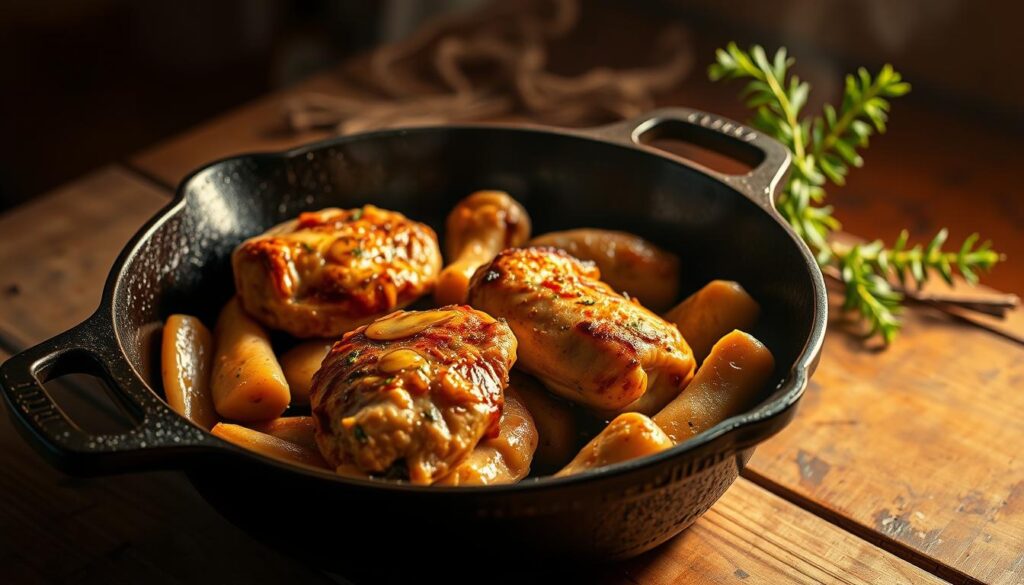
Mastering Heat Control
Your cast iron skillet needs proper preheating. Place it over medium heat for 5 minutes before adding oil. This prevents sticking and creates that golden sear everyone loves. If smoke appears, lower the temperature slightly – patience pays off.
Uneven cooking often stems from overcrowding. Leave space between pieces so heat circulates freely. Rotate the pan halfway through if your stove has hot spots. For bone-in cuts, extend oven time by 3-4 minutes to ensure thorough cooking.
Digital thermometers are game-changers. Insert the probe into the thickest part without touching bone. Wait 3 seconds for an accurate read. “165°F is your safety sweet spot,” says chef Michael Sullivan. “But pull meat at 160°F – residual heat finishes the job.”
Seasoning mishaps? Taste your marinade before adding protein. Adjust with a pinch of salt or dash of pepper if flavors feel flat. Remember: sauces reduce and intensify during cooking, so start slightly milder than desired.
Conclusion
Mastering this dish requires just three key steps: marinate, sear, and bake. You’ll achieve crispy skin and juicy meat by patting pieces dry before cooking and using your cast iron skillet’s even heat. The 30-minute soak in honey and soy sauce builds deep flavor without complicated prep.
Perfect results come from timing. Sear thighs skin-side down first for that golden crust, then finish in the oven. Pair with steamed rice or roasted veggies for a complete weeknight dinner that satisfies. Leftovers? Shred the protein for next-day grain bowls or wraps.
Your skillet does double duty – it transitions from stovetop to oven seamlessly. Try sprinkling toasted sesame seeds on top for extra crunch. Adjust the sauce ratio to match your taste, adding more garlic or a chili kick.
Share your twist on this recipe with friends, then explore other easy recipes using these techniques. From first bite to last, you’ve got a new staple for your dinner rotation.
FAQ
Why use a cast iron skillet for this recipe?
Cast iron retains heat evenly, creating a crispy exterior while keeping the meat juicy. Its durability also makes it ideal for stovetop-to-oven cooking, which this dish requires.
Can I substitute honey with another sweetener?
Yes! Maple syrup or brown sugar works well. Adjust quantities to taste, as these alternatives may alter the sauce’s thickness or sweetness slightly.
How long should I marinate the chicken?
Aim for at least 30 minutes, but 2–4 hours maximizes flavor. Avoid over-marinating (beyond 12 hours), as the soy sauce can make the meat overly salty.
What internal temperature should the chicken reach?
Use a meat thermometer to ensure it hits 165°F (74°C). Thighs have a higher fat content than breasts, so they stay tender even if cooked slightly longer.
Can I use fresh garlic instead of minced?
Absolutely. Freshly chopped garlic adds a sharper flavor. Use 1–2 cloves per tablespoon of pre-minced garlic for a bolder taste.
How do I prevent the sauce from burning?
Keep the heat medium-high and stir the sauce frequently. If baking, cover the skillet with foil after searing to lock in moisture and prevent scorching.
What sides pair well with this dish?
Serve over steamed rice, quinoa, or in grain bowls with veggies like bok choy or snap peas. Toasted sesame seeds add crunch and visual appeal.
Can I meal prep this recipe?
Yes! Cooked thighs stay fresh in the fridge for 3–4 days. Reheat in the oven or skillet to maintain texture—avoid microwaving, which can make them soggy.

